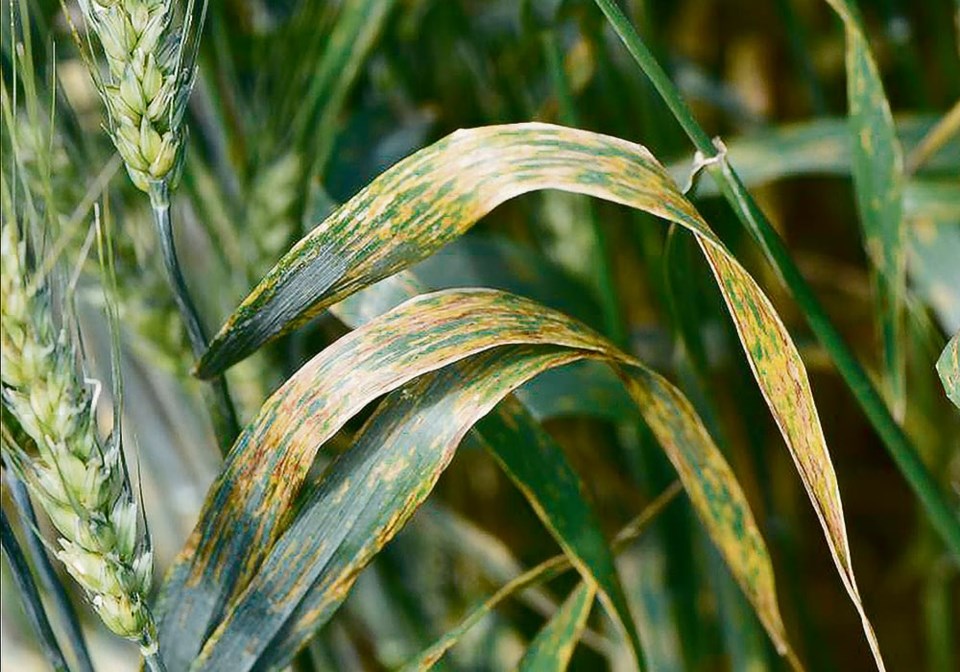WESTERN PRODUCER — In the last few years, Andrew Friskop has tested many, many products on bacterial leaf streak — a disease of wheat, barley and cereal crops.
The results were easy to analyze.
“Long story short, nothing,” said Friskop, a plant pathologist with North Dakota State University. “There’s nothing out there…. There’s nothing we can spray on it.”
For years, Friskop has been monitoring the spread of bacterial leaf streak in North Dakota. No crop protection product works on the disease, mostly because it’s a bacterium.
Farmers and the crop protection industry have little experience in battling a bacterial crop pest, especially on a broad acreage crop like wheat or barley.
BLS is caused by a group of bacteria called Xanthomonas translucens. A few different pathovars, or strains within the group, can damage cereal crops.
The bacterium persists on crop residue, but in many cases, it arrives in the field from cereal seed contaminated with the disease. Wind and rain also move the bacteria from plant to plant.
The defining symptom of bacterial leaf streak is dark green, water-soaked streaks on the leaf. Plant pathologists sometimes describe it as a shiny glaze of bacteria on the leaf.
“If the crop is dry (and) you take that leaf tissue and you angle it in the sun, you may see masses of the bacterial cells on the leaf surface,” Kelly Turkington, a plant pathologist with Agriculture Canada in Lacombe, Alta., said in 2021.
“It gives the leaf a bit of a glazed doughnut appearance…. You’ll see a shellac or coating on the lesions.”
The disease reduces photosynthesis and robs the wheat crop of yield.
“In wheat, it hits the flag leaf and (you) start seeing yield reductions (from) that,” Friskop said.
Disease surveys from 2022 and 2023, show that BLS has become a pervasive problem for cereal growers in North Dakota.
“We found bacterial leaf streak in seven to eight percent of fields,” Friskop said.
“Within a field… it’s around 10-12 percent (of plants).”
In Saskatchewan, BLS is less common.
“We think the (disease) is already built up in the U.S. Whereas in Saskatchewan, it’s not still widespread…. We don’t have a lot of inoculum in our fields,” said Constanza Fleitas, a plant pathologist from the University of Saskatchewan, who has studied BLS for about three years.
The actual amount of BLS in Saskatchewan could be higher because plant pathologists surveyed wheat and barley fields across the province.
Disease experts have relied on producers and agronomists sending in samples, to understand where it is and how much bacterial leaf streak is in Saskatchewan.
In 2021 and 2023, the number of samples coming to the U of S was relatively low, because of drought and dry conditions that put a lid on plant disease.
“In 2022, we were getting more samples (of BLS) because it was a (wetter) year,” Fleitas said.
“(But) we’re not seeing economic levels, except in two cases.”
One case was a Saskatchewan farmer who bought seed from Alberta. Seed contaminated with BLS is a major factor in the disease’s spread.
BLS is more common in southern Alberta, particularly on irrigated land.
The disease was present this summer in possibly “hundreds” of irrigated fields of barley, durum and spring wheat, said Mike Harding, a plant pathologist with Alberta Agriculture.
In Saskatchewan, Fleitas is working on a map to pinpoint where BLS has been found and to identify the type of BLS found.
She’s also working with other plant pathologists, like Kelly Turkington of Agriculture Canada, to understand if wheat and barley varieties are resistant to the disease.
Results from a disease nursery in Lacombe, Alta, produced hopeful results.
“Some cultivars were decimated by the disease, others were looking pretty good,” Fleitas said.
“There are cultivars that have resistance…. But not all these varieties are Canadian varieties.”
Still, the resistance genes from those varieties could be bred into Canadian wheat and barley.
Back in North Dakota, plant pathologists like Friskop have learned that genetic resistance may be the best tool for fighting BLS.
There is wheat in North Dakota with more resistance to BLS, but growers aren’t always choosing those varieties.
“The bad thing is most of the (varieties) 小蓝视频 grown on a higher acreage, are below average for bacterial leaf streak resistance,” he said.
“When you’re below average (for resistance), you can see 15 percent (yield losses) in a bad year.”
The severe drought of 2021 was a setback for BLS, but Friskop is worried that the bacterial disease could rebound in 2024 or 2025.
“It kind of plateaued (in 2022 and 2023),” he said. “But I still (consider) it our No. 1 disease.”
SASKTODAY.ca is Saskatchewan's home page. Bookmark us at this link.




